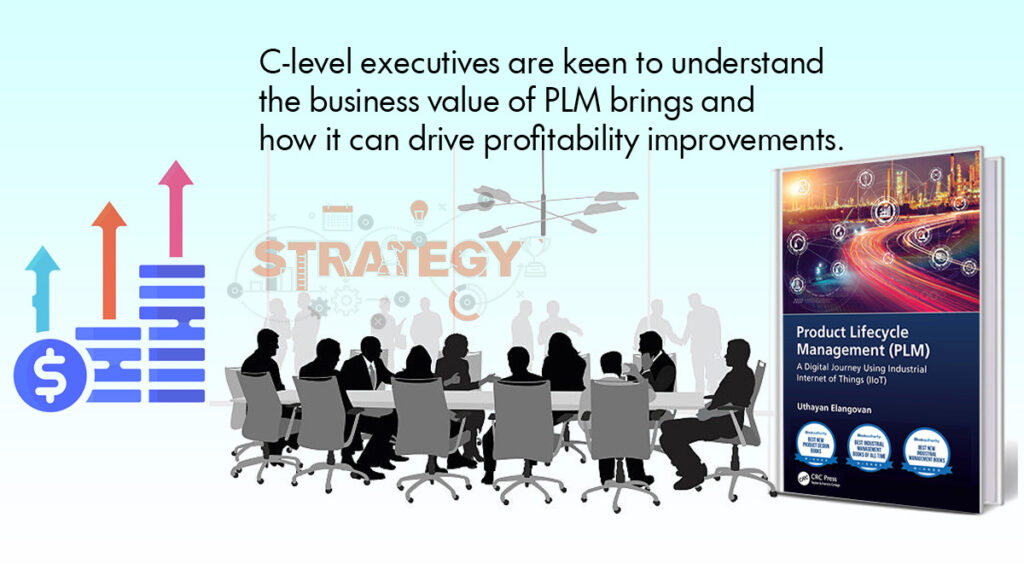C-level executives are keen to understand the business value of PLM brings and how it can drive profitability improvements.
Introduction:
In today’s highly competitive manufacturing landscape, companies face numerous challenges to stay ahead. To achieve sustainable growth and maintain a competitive edge, manufacturing enterprises must effectively manage their product lifecycles. Product Lifecycle Management (PLM) encompasses the processes, technologies, and strategies involved in managing a product from its inception to retirement. In this article, we will discuss why manufacturing enterprises require PLM and highlight its business value, total cost of ownership, return on value, and return on investment.

Business Value of PLM:
- Enhanced Product Innovation: PLM provides a centralized platform for collaboration, allowing cross-functional teams to share ideas, insights, and feedback. This promotes innovation by facilitating the integration of design, engineering, manufacturing, and other departments. By streamlining communication and enabling concurrent engineering, PLM accelerates the product development process and brings innovative products to market faster.
- Improved Product Quality: PLM enables manufacturers to establish rigorous quality control processes throughout the product lifecycle. By capturing and analyzing data from various stages, such as design, testing, and manufacturing, companies can identify and address potential quality issues early on. This proactive approach minimizes costly rework, recalls, and warranty claims, leading to higher customer satisfaction and stronger brand reputation.
- Enhanced Supply Chain Collaboration: PLM helps manufacturers establish seamless collaboration with suppliers, enabling them to align their processes and ensure timely delivery of high-quality components. By integrating suppliers into the PLM system, enterprises can optimize inventory levels, reduce lead times, and mitigate supply chain risks. This collaboration drives efficiency, reduces costs, and improves overall supply chain performance.
- Efficient Change Management: Throughout a product’s lifecycle, changes are inevitable, be it due to customer requirements, regulatory updates, or market dynamics. PLM provides a structured change management process, ensuring that modifications are systematically tracked, assessed, and implemented. By minimizing the risk of errors and delays, PLM enables manufacturing enterprises to respond quickly to market demands and maintain agility in a rapidly changing business environment.
Total Cost of Ownership:
While implementing PLM involves an initial investment, it ultimately reduces the total cost of ownership over a product’s lifecycle. Some key aspects to consider include:
- Reduced Rework and Scrap: By integrating design, engineering, and manufacturing data, PLM minimizes errors and rework, leading to significant cost savings.
- Improved Operational Efficiency: PLM streamlines processes, eliminates bottlenecks, and reduces cycle times, resulting in improved productivity and reduced labor costs.
- Enhanced Regulatory Compliance: PLM helps manufacturers stay compliant with industry standards and regulations, avoiding penalties and costly rework to meet compliance requirements.
Return on Value and Return on Investment:
PLM delivers substantial returns on both value and investment, including:
- Increased Revenue: Faster time-to-market, improved product quality, and innovative product offerings result in increased customer satisfaction and loyalty, leading to higher sales and revenue growth.
- Cost Savings: Through optimized processes, reduced rework, and better inventory management, PLM helps cut costs across the entire product lifecycle, improving profit margins.
- Competitive Advantage: By streamlining operations, accelerating innovation, and facilitating collaboration, PLM enables manufacturing enterprises to differentiate themselves from competitors, capturing market share and sustaining long-term growth.
- Scalability and Flexibility: PLM systems are designed to accommodate evolving business needs and support scalability. As enterprises expand their product lines or enter new markets, PLM provides the foundation for efficient product management, ensuring continued business success.
Key Performance Indicators:
KPI play a crucial role in measuring the success and effectiveness of PLM implementation in manufacturing enterprises. Here are some important KPIs that can be used to evaluate the performance and impact of PLM:
- Time-to-Market: This KPI measures the average time it takes to bring a new product to market, from the initial concept to availability for customers. PLM should aim to reduce this time by streamlining product development processes, improving collaboration, and eliminating bottlenecks.
- Product Development Cycle Time: This KPI measures the average time it takes to complete each stage of the product development process, from design to manufacturing. PLM should focus on reducing cycle times by enabling concurrent engineering, automating workflows, and improving cross-functional collaboration.
- Product Quality Metrics: These metrics assess the quality of products throughout their lifecycle. They may include metrics such as product defects per unit, warranty claims, customer complaints, and customer satisfaction surveys. PLM should aim to reduce defects, minimize warranty claims, and increase customer satisfaction through improved design, testing, and quality control processes.
- Cost of Quality: This KPI measures the costs associated with ensuring product quality, including prevention, appraisal, and failure costs. PLM should help reduce the cost of quality by identifying and addressing quality issues early on, improving supplier collaboration, and implementing effective quality control measures.
- Return on Investment: ROI measures the financial returns generated from the investment in PLM. It compares the benefits derived from PLM implementation to the costs incurred. ROI can be calculated by dividing the net gain from PLM by the cost of implementation and multiplying by 100 to get a percentage. A positive ROI indicates that PLM is delivering value to the organization.
- Cost Savings: This KPI measures the cost savings achieved through PLM implementation. It includes reductions in rework, scrap, inventory costs, and improved operational efficiency. Cost savings can be tracked and measured against predefined targets to evaluate the effectiveness of PLM.
- Supplier Performance: One of the key KPI is the assessment of the performance of suppliers in terms of quality, delivery time, and cost. PLM should enable better supplier collaboration, allowing manufacturers to track and evaluate supplier performance metrics and drive continuous improvement in the supply chain.
- Innovation Metrics: These metrics evaluate the success of PLM in driving innovation within the organization. They may include the number of new product ideas generated, the percentage of revenue from new products, and the number of patents filed. PLM should facilitate collaboration and knowledge sharing, leading to increased innovation and a strong product pipeline.
- Compliance Metrics: These metrics measure the level of regulatory compliance achieved through PLM. They include metrics such as the number of non-compliance incidents, regulatory penalties, and successful audits. PLM should help manufacturers meet regulatory requirements, mitigate compliance risks, and avoid costly penalties.
- Customer Retention and Acquisition: These metrics assess customer loyalty, satisfaction, and acquisition rates. They can include metrics such as customer retention rate, customer lifetime value, and new customer acquisition cost. PLM should contribute to improved product quality, faster time-to-market, and customer-centric product development, leading to higher customer retention and acquisition rates.
By tracking and analyzing these KPIs, manufacturing enterprises can assess the effectiveness of the PLM implementation, identify areas for improvement, and make informed decisions to optimize the product lifecycle management processes.
Conclusion:
In the highly competitive landscape of manufacturing, PLM is crucial for enterprises seeking sustainable growth and a competitive edge. PLM drives business value by enhancing product innovation, improving quality, enabling supply chain collaboration, and streamlining change management processes. With a reduced total cost of ownership, PLM delivers significant returns on both value and investment, including increased revenue, cost savings, and a competitive advantage. Manufacturing enterprises that embrace PLM can unlock their full potential, achieve operational excellence, and thrive in an ever-evolving market.
Gain a competitive edge in the market by implementing PLM and tapping into our consultation services.
The utilization of PLM solutions such as OpenBOM PLM for SME and Windchill PLM for Discrete Manufacturers presents a transformative opportunity for companies aiming to elevate their product development endeavors. Whether you are seeking a PLM upgrade, implementation, rollout, or ongoing support, our consulting firm is well-equipped to accompany you throughout the entire process. With our expertise and guidance, you can seamlessly transition towards a more efficient and successful approach to new product development. Together, we will unlock the full potential of PLM, empowering your organization to achieve its business objectives with confidence and distinction.


